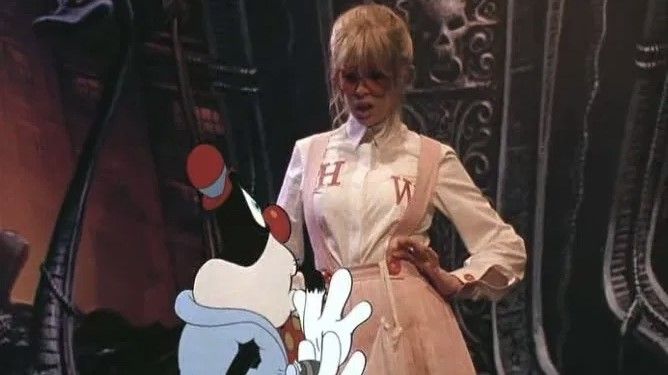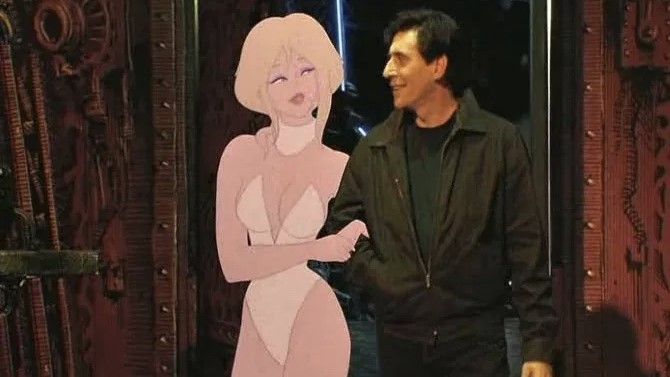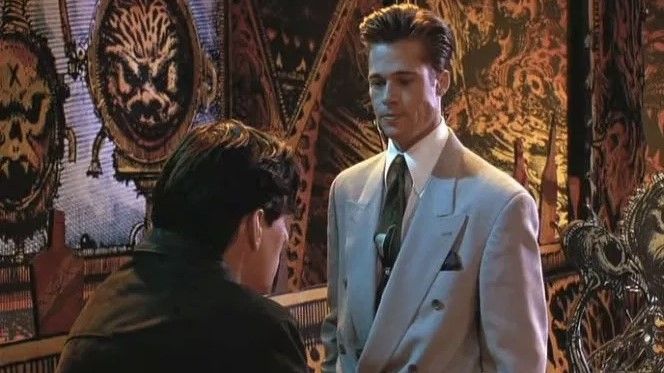
If you were in Hollywood in July of 1992, you might have spotted the star of Ralph Bakshi’s newest movie in the neighborhood. Well, actually, you couldn’t miss her. That summer, a 75-foot tall steel cutout of blonde bombshell Holli Would, the animated starlet of Cool World, was added to the iconic Hollywood sign. She sat on the “D,” looking coyly out at what Paramount Pictures might have imagined to be audiences excited for the animator-provocateur’s newest project. Instead, those caught in Holli’s gaze were decidedly unhappy, protesting for the cutout’s removal. According to The Hollywood Reporter, one Paramount executive described the stunt as “very Hollywood.” In a way, this mirrored the troubled production of the film itself. For, as the movie-going public was about to find out, Cool World was not the movie Bakshi planned it to be — nor one they might have embraced. Behind the scenes, what could have been a horror-adjacent, boundary-pushing film instead collapsed into Roger-Rabbit ripoff territory: Very Hollywood indeed.
Born in Palestine to a Jewish family, Ralph Bakshi grew up in places like Brooklyn and Foggy Bottom, environments that would greatly shape his film catalog. After graduating from the School of Industrial Art, he worked in animation until the debut of what might be his most well-known feature — an adaptation of Fritz the Cat. It was the first American animated film to be rated X, an unsurprising decision considering the movie’s uncompromising depictions of sex, drugs, and social issues. Bakshi’s next film,1973’s Heavy Traffic critiqued the mafia, while 1975’s extremely controversial Coonskin prompted public backlash due to its depiction of Black characters. (While CORE decried the film, the NAACP supported it.) Throughout the ’70s and ’80s, Bakshi continued to make feature films, eventually pivoting to television — and may have continued to work in that realm had there not been a cultural reset in 1988: A little comedy called Who Framed Roger Rabbit. The noir-for-kids follows a detective (Bob Hoskins) as he works with a cartoon rabbit to solve a mystery. What if someone made a horror film in a similar mold, including a cast made up of both live action actors and animated characters? Bakshi’s background in adult animation made him the perfect man for the job. All he had to do was put it in motion.
Cool World: It’s Alive!
By the time Cool World began formulation, it had been years since Bakshi’s last feature film. This one would be a bit different: Live action actors would mingle with their animated counterparts on-screen. The twist? Cool World would be for adults. The plot would follow a half-human, half-drawing — the child of a cartoonist and a cartoon named Debbie Dallas — on a journey to kill its father. (After all, if you were the product of an unnatural union, wouldn’t you be a little upset? And possibly always in pain?) The selling point seemed to be as much the animation as the project itself. In a recent interview with The Independent, Bakshi said that, though he didn’t know how it would’ve been done, he wanted to make “the kid” itself half-animated. The studio bought the idea, and Cool World was on its way to being born. Unfortunately, the path to realization would not be a straightforward one.
Interference Begins
If there’s one name in the Cool World story that sparks contention, it may well be Frank Manusco Jr.’s. Animation fans have long repeated the rumor that Bakshi punched Manusco Jr. for changing the movie’s script behind his back, but Bakshi himself now insists that isn’t true. What is true, however, is that Cool World‘s script was definitely rewritten once in the studio’s grasp. What had been a horror-adjacent, gritty movie was sanded down into something general audiences might find more palatable. The murderous half-cartoon child was gone, replaced by a detective-type character trapped in the world of the “doodles.” The kid’s quest to murder its parents was now a near-incomprehensible tour through the cartoon and human worlds in turn. And then there was the issue of casting: Bakshi wanted Drew Barrymore for the bombshell cartoon role — her turn in 1995’s Batman Forever proves she would have been a good fit — but the studio thought the movie’s other star, Brad Pitt, was too green and required Bakshi to pick the more proven Kim Basinger to balance out the cast. (Basinger seemed to have a poor concept of the film’s target audience, telling Bakshi she wanted to show it to sick kids in hospitals as charity work.) The movie was beginning to get away from him. To make matters worse for unsuspecting general audiences, Bakshi told animators to draw whatever they wanted, resulting in an extremely busy visual landscape. What was once a scary, edgy film about revenge would now follow an army veteran (Pitt) who, after a car accident, becomes trapped in Cool World. The production had turned 180 degrees, and even an original song from David Bowie couldn’t fix it.
Cool to Uncool
Once all the changes had been made to Cool World, its plot became nigh-unrecognizable. Against a Las Vegas background, the movie pits Basinger’s re-named animated vixen Holli Would against both a cartoonist (Gabriel Byrne) and Pitt’s cop as she attempts to seduce a human in order to escape into our world. (If the plot is hard to make sense of here, that’s because the movie doesn’t make much of it, either. Brad Pitt described it as “Roger Rabbit on acid” in 1992.) The neon colors and stony animation remind one of Bakshi’s early work, but fluffy dialogue and directionless sequences strand the film in a Sisyphean attempt to make meaning of itself. In short, a few seconds of Cool World feel like a lot more=. Critics weren’t kind to the film, and it currently sits at a four percent on Rotten Tomatoes. But Bakshi? “I used to disparage it, but not anymore,” he told the Independent. “Cool World has some of the best animation I’ve ever done.”
Indeed, despite the film’s many flaws, there’s really nothing quite like Cool World — Bakshi’s last feature film for now. Though the plot is incomprehensible, the visuals are often slick and trancelike, characters moving to the soundtrack in hypnotic patterns. Basinger and Pitt don’t quite click, but their clunky chemistry takes on a life of its own. And in some moments, between the animation cells, you can see what Ralph Bakshi intended to be cool.
[via]










